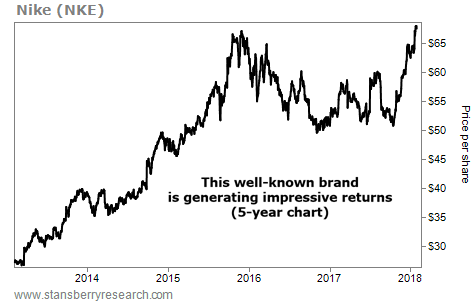| Home | About Us | Resources | Archive | Free Reports | Market Window |
How to Diversify With Four Unique Real Estate InvestmentsBy
Wednesday, January 31, 2018
If you want to profit from real estate stocks, you need to know one important thing...
Not all real estate stocks are the same.
Some real estate stocks offer growth... Others offer value... And others offer income.
Different real estate stocks also present different risk/reward profiles. At one end of the spectrum, we have stable, low-volatility, income-generating investments... At the other end, we have speculative growth plays... And in the middle, we have everything in between.
As an investor, this gives you the flexibility to structure your real estate portfolio in a way that suits your preferred risk/return profile. And it allows you to diversify.
So let's go over the four different types of real estate stocks...
1. Developers
These property companies are like manufacturers. They buy raw material (land), they manufacture (build), and then they sell the completed product.
This is a buy-and-sell model. It's all about buying land, building, and selling... then repeating the process all over again. The faster and more efficiently a company can do this, the more profitable it can be.
Pure developers all have certain characteristics... Their businesses are highly cyclical, as are their earnings. They have the highest asset turnover of all property models – that is, they don't hold on to assets for long periods.
And in many markets, these stocks have a high beta. That means that they tend to go up and down at a greater rate than the overall market. So investors should be ready to stomach higher volatility.
2. Investment-property companies
This group typically buys or builds properties to hold for longer-term rental income and capital growth.
Their rentals and capital values can be cyclical. But their earnings are more reliable than those of developers, because they come from regular rent payments.
Finally, these companies typically have low asset turnover (they hold on to assets for long periods), and therefore a lower return on equity or return on capital.
3. Real estate investment trusts (REITs)
These real estate companies follow specific rules dictating what they can do and how they behave.
REITs hold investment properties for the long term. The law requires them to pay out at least 90% of their net income as dividends to their shareholders.
In most jurisdictions, these companies can only undertake a set amount of development. And some places set maximum "gearing" (borrowing) levels, or allow REITs to hold only properties in certain jurisdictions.
Such vehicles are designed to provide a low-risk, high-dividend asset class for investors in real estate...
Earnings and dividends tend to be predictable and have low volatility. However, earnings growth tends to be low (since it is largely based on rental growth), along with return on equity.
REITs also tend to have a lower beta. Their shares typically go up less than the overall market, but they also go down less in a falling market.
4. Real estate services, suppliers, and contractors
This group includes real estate agencies, property-management companies, real estate finance companies, construction companies, and building-materials suppliers.
Many banks have a high proportion of their total loan books allocated to real estate of one kind or other – including real estate services, such as materials and equipment suppliers. (For example, in Asia, many banks have had more than 50% of their loan books exposed to real estate at various times.)
Now we've gone over the four main types of real estate stocks. You may have good reasons to focus on one type over another, depending on what's going on in the market...
For example, in an environment of low interest rates, investors usually start searching for low-risk yields. In some markets, that demand has led investors to REITs... Their dividend yields tend to be substantially higher than interest on bank deposits or bonds.
Or consider this... Housing development slowed dramatically in many countries in the immediate aftermath of the 2008 global financial crisis. As demand for housing came back on line with the economic recovery, it was met with a shortage of new supply. So developers were needed to fill the gap... which increased their prospects.
Rapid growth in populations or exports can also increase the demand for new housing, buildings, or manufacturing centers... another positive tailwind for developers.
So before you invest in real estate stocks, consider the risks, rewards, and what's happening in the market.
Good investing,
Peter Churchouse
Further Reading:
In this essay, Peter explains one of the best ways to earn income from real estate – without the stress of being a landlord. Learn more here: Five Reasons to Add This Income Investment to Your Portfolio.
"Adding real estate is one of the easiest ways to boost your income as we head into 2018," Peter says. And if you're like most investors, you probably don't own enough of it... Read more here: Here's Why You Should Own More Real Estate Next Year.
Market NotesA WORLDWIDE BRAND HITTING RECORD HIGHS Today, we check in on a company with an impressive reputation...
Businesses with iconic brands enjoy tremendous customer loyalty. That's because they have a broad reputation for superior products... And their customers are willing to pay premium prices for that consistent quality. Right now, one famous brand is picking up steam...
We're talking about Nike (NKE), one of the world's most popular athletic brands. It built its $110 billion empire selling shoes, apparel, and sports accessories. Now, shareholders are reaping the benefits of a four-year, $12-billion buyback program. The buybacks increase the value of Nike's shares and give investors a bigger piece of the pie. It's a sign Nike has confidence in its business – and it's what we like to see in an investment...
As you can see in the chart below, Nike shares are on a tear. The stock is up around 27% in the past year. And shares recently hit fresh all-time highs. As long as consumers keep snapping up their favorite shoes, expect shares of this beloved company to keep climbing...
 |
Recent Articles
|



